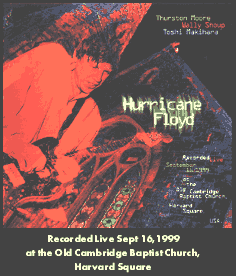
Thurston Moore  electric guitar solo acoustic guitar |
Wally Shoup alto saxophone |
Toshi Makihara |
 |
|
Hurricane Floyd As guitarist for Sonic Youth, Thurston Moore needs no introduction. It's perhaps not as well known that he is also a respectful student and selfless practitioner of the art of free improvisation. Over the years, Moore has sought out the best players to work with and learn from, including legendary figures such as free jazz pianist Cecil Taylor and English improvising saxophonist Evan Parker as well as lesser known veterans like Shoup and Makihara. Shoup is one the alto saxophone's most passionate poets, by turns playful and raw, with a rock-hard tone and fine control over the inflections and color of his notes. A free improviser, who has operated outside the commercial realm since 1974, Shoup lived in Birmingham, Alabama and worked with musicians like guitarist Davey Williams and violinist Ladonna Smith, before moving to Seattle in 1985. Since then, he has maintained his commitment ot improvisation byleading numerous groups, most notably Project W, and by organizing the |
long-running Seattle Improvised Music Festival.Wherever he's lived, Shoup, who is also and established painter and a regular contributor to varios music publications, has maintained an uncompromised commitment to the aesthetics of freedom. Born in Japzn, where he studied with great improvising percussionist Sabu Toyozumi, Toshi Makihara is a disciplined and precise percussionist with fast reflexes. Now based in Philadelphia, Makihara has worked with filmakers, butoh dancers, as well as improvising musicians such as William Parker, John Zorn, and Peter Brotzmann. He's also a man with Zen-likesense of the profundity of the absurd-atone point during the concert, he employed a Wile E. Coyote doll and a pair of gloves with long red plastic strings attached. These were not mere gimmicks, but tools, however surreal, to create uniquely appropriate sounds. Playing for the first time together in this concert, these three very different musicians-the indie rock star, the American saxophone original, and the expatriate Japanese percussionist-met as equals and generated a collective music of enormous passion. It's not as easy as they make it seem. Free improvisation can be just as bound by convention as hard bop or hip hop. But if the musicians involved have ears big enough and spirits generous enough to transcend the straight jacket of categories and embrace the whole universe of musical possibilities, and if they have the courage and craft to follow sound where it takes them, then free improvisation can be truly free. This is truly free improvisation. |
listen to how the first track, "1", germinates from small kernels of sound-a warble from Shoup, hummingbird-wing flutters from Makihara, a glowing scrap from Moore. Shoup's command of inflections and color is especially critical, as anguished saxophone cries call out to Moore's glassy roars over billowing cymbal washes. Moore is likewise a master manipulator of sound, stretching tones wire thin, inflating them into fat hollow bubbles of white noise that enshrouds the others. Moore's massive overtones defy gravity as they accumulate, towering higher and higher over the drums and sax; it's like getting hit on the head with an alp. Every flick of Makihara's sticks seems to articulate the imiplied energy waiting to be unleashed. They form a molten ensemble in which there is no lead voice but from which individual voices rise like flares on the surface of the sun before falling back into the boiling collective. Above all, this is music created out of careful listening and intuitive logic, not random movement or noise. Sometimes new developments are logicalj; sometimess they defy rational thought. It's the openness of the trio that counts and their acceptance of the collective enterprise. For instance, the track 3: " Retribution, of Sorts" opens with Shoup's bone-weary, preacher-man blues solo, which gets absorbed into a collage of interlocking sounds that eventually bursts into some of the most cathartic playing on the disc. The quietly anxious passage that follows is electric with the anticipation. You can sense forces gathering in the music once again. Then Moore's speaking-in-tongues guitar scrabble, Shoup's alto lamentations and the volcanic power straining withing Makihara's percussion erupt again, setting in motion a long coda of slow rises and falls, a final climatic, rush, and quiet expiration. |
Moore opened the concert with a solo acoustic set of eight songs, each of which created its own little sonic world. On the one included here, "Altar Boy", Church Basement" Moore's steadystrumming drives the music forward and his careful manipulation of overtones cast up chiming clouds of notes. The church's resonate sanctuary loved the overtones and they hung in the air as ethereal and transparent as ghosts. The music had a hypnotic effect quite unlike the trio's music but Moore's ability to use song form as a laboratory for sonic exploration is totally in keeping with the adventurous spirit of the trio's free improvisations. Clearly that adventurous spirit exists independent of style or genre, it lives in the hearts and minds of the improvisers. Ed Hazell Ed Hazell is a regular contributor to the Boston Phoenix,Jazziz, Signal and Noise and other music publications. |